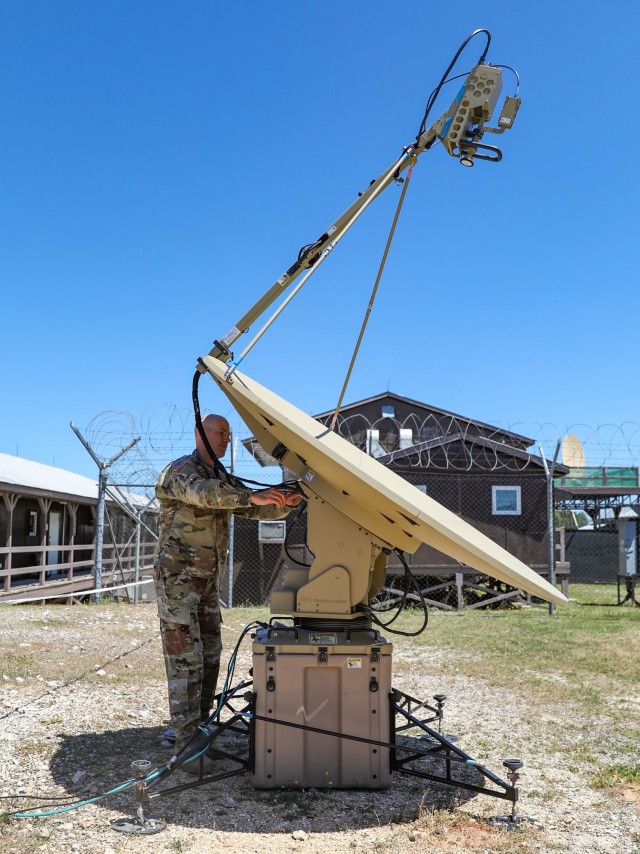
The US Army is looking to deepen the involvement of private-sector satellite communications providers to satisfy its needs as the force embraces MDO and moves towards a division-based structure.
On 26th September the US Army commissioned DRS Global Enterprise Solutions and Intelsat to work on a pilot effort for the force’s Satellite Communications (SATCOM) as a Managed Service initiative. Known as SAAMS, the initiative forms part of the army’s Unified Network Plan. The plan was published in 2018 and forms a cornerstone of the US Army’s embrace of the Multi-Domain Operations (MDO) philosophy. MDO focuses on the inter- and intra-force connectivity of all military assets, notably personnel, weapons, sensors, bases and capabilities at all levels of war. The purpose of MDO is to provide forces the ability to take faster and better quality decisions than their adversaries. As the plan articulates, the army intended to build an MDO-capable force by 2028. Alongside SAAMS’ contribution to the army’s developing MDO posture it will inform network design concepts for the Army 2030 initiative. Army 2030 is fundamental redesigning of the force’s organisation. Key to this reorganisation is the army’s adoption of a division-based order-of-battle in contrast to its existing brigade-level orientation.
The US Army’s Command, Control and Communications – Tactical Programme Executive Office (PEO C3T) is responsible for SAAMS. A PEO C3T spokesperson told Armada that as part of the Unified Network Plan “the programme office is exploring options to more affordably deliver satellite communications services to end user units.” Key to the SAAMS approach is a belief that it may not make sense to provide all army units with continuous SATCOM coverage all the time “when connectivity and hardware can be surged to point of need for deployments and other operations such as humanitarian missions.”
Costs and Capabilities
The SAAMS model could potentially provide “bundled equipment, services and bandwidth, on an as-needed basis, with the scalability to expand or contract as missions change, helping to reduce on-hand inventory, satellite airtime and cost,” the spokesperson continued. A further benefit of SAAMS is that it could accelerate the speed at which the army obtains cutting-edge SATCOM technology. New capabilities could be leased as and when required by the force via the private sector. This approach contrasts with “procuring, fielding, sustaining and modernising the equipment in house.” A crucial aspect of SAAMS is to have SATCOM capabilities that are flexible and configurable to changing mission requirements.
Although the US Army and US Department of Defence does possess its own dedicated SATCOM constellations, these resources are not unlimited because of their cost and level of demand. To this end, the army is interested in exploring commercial high-throughput, low-latency SATCOM services. As well as ensuring SATCOM provision, using commercial services could reinforce resilience. Likewise, SAAMS could help to push fast data-rate, resilient, commercial SATCOM down to small tactical units.
US and allied adversaries will be aware of the premium that MDO places on connectivity and will work hard to disrupt communications links through electronic, cyber and kinetic attack. Having several conduits, SATCOM and conventional, available to forces increases the number of links those units have available. “The more pathway options that exist for data to travel through, the more resilient the network becomes.”
As the army revealed in a press release announcing the SAAMS pilot, this initiative will help inform the force on the “potential use of commercially leased SATCOM network services that would be flexible and tailorable to changing mission needs, versus procuring, fielding, sustaining and modernising the equipment in house.” The press release continued that the year-long SAAMS pilot will include provision for “six months of turnkey, end-to-end managed subscription services to support connectivity to commercial teleports and internet services.” The intention is to not only enhance the SATCOM connectivity of units in the army’s manoeuvre force but also to shore up PACE (Primary, Alternate, Contingency and Emergency) communications.
SAAMS Structure
According to the press release, the SAAMS pilot will commence in the first quarter of the 2024 fiscal year and cover several areas around the world. The pilot constitutes a blanket purchase agreement. As per this agreement, each of the two vendors will “provide commercial SATCOM subscription services, which include SATCOM coverage in different locations, terminals, bandwidth, training if required by the unit and help desk services,” said the spokesperson. The document emphasised that “the intent is not to create a separate SAAMS evaluation event, but to enable operational units to use the capability to best suit their needs and roll it into existing training events.” Although two companies are involved in the pilot initiative, the PEO C3T “intends for multiple vendors to be part of a future SAAMS business model approach, providing opportunities for increased innovation across the commercial SATCOM industry,” the spokesperson continued.

Once the SAAMS pilot is complete, the army will draft an assessment to inform future SAAMS efforts, the spokesperson added. As well as informing the Army 2030 project, the pilot will help manage a marketplace of subscription services encompassing SATCOM capabilities being used in the private sector. The marketplace will take the form of a contractual vehicle. This vehicle will allocate funding to provide the desired commercial SATCOM requirements for a twelve-month period.
Outpacing the Threat
The SAAMS pilot is doubtless a step in the right direction for US Army communications. Both the embrace of MDO and the Army 2030 vision place a premium on communications. At the same time, SATCOM capacity must expand to cope with existing and anticipated future demand. Resilience needs to be built into manoeuvre force network architectures to ensure link survivability. Establishing the SAAMS initiative will be an important step in meeting these challenges.
by Dr. Thomas Withington












